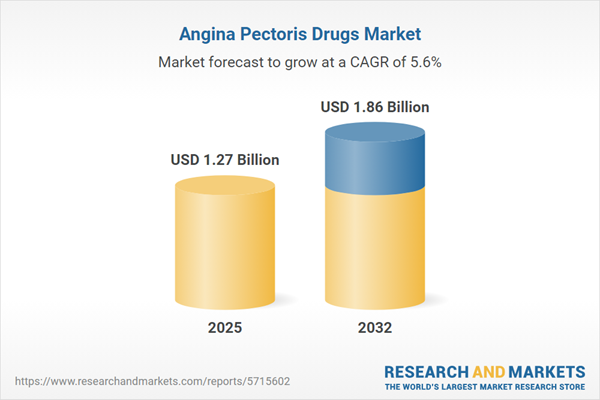Speak directly to the analyst to clarify any post sales queries you may have.
The angina pectoris drugs market is in a period of transformative change as pharmaceutical developments, digital health technologies, and evolving commercial models reshape competition and clinical care approaches. Senior decision-makers need timely, actionable insights to support informed strategies, operational resilience, and superior patient outcomes in this dynamic environment.
Market Snapshot: Angina Pectoris Drugs Market Size and Outlook
The global angina pectoris drugs market is expanding, rising from USD 1.20 billion in 2024 to USD 1.27 billion in 2025, and projected to reach USD 1.86 billion by 2032. This reflects a compound annual growth rate (CAGR) of 5.60%. Key drivers include the increasing burden of cardiovascular disease, expanding therapeutic portfolios, and broader adoption of both well-established and innovative pharmaceuticals. The market is also shaped by evolving clinical practices and rising interest in personalized medicine, which encourage deeper segmentation and specialized product uptake. Regional diversity in regulations and reimbursement continues to guide company strategies and cross-industry partnerships within the cardiovascular sector.
Scope & Segmentation: Angina Pectoris Drugs Market Structure
- Drug Classes: Covers enalapril, lisinopril, aspirin, P2Y12 inhibitors, beta blockers, dihydropyridines, nondihydropyridines calcium channel blockers, as well as long- and short-acting nitrates, providing extensive choices to match patient profiles and therapeutic needs.
- Dosage Forms: Includes capsules, injections, tablets, and patches, enabling tailored selection for both acute and chronic care while supporting adherence and clinical effectiveness.
- Routes of Administration: Encompasses intramuscular, intravenous, controlled release, immediate release, spray, tablet, reservoir, and single-layer technologies to suit diverse patient scenarios and care settings.
- Distribution Channels: Spans hospital pharmacies, B2B online pharmacies, B2C channels, and retail outlets, broadening pathways for product movement and amplifying reach in developed and emerging segments.
- End Users: Addresses public and private clinics, hospitals, caregiver-supported homecare, and self-managed care, illustrating the range of settings that influence adoption patterns and product requirements.
- Geographic Regions: Focuses on North America, Latin America, Europe, Middle East, Africa, and Asia-Pacific, alongside key markets such as the United States, Canada, Brazil, United Kingdom, Germany, France, China, India, and Japan, each with distinct regulatory settings and market dynamics.
- Company Coverage: Major players include Novartis AG, Pfizer Inc., Sanofi S.A., Bayer AG, AstraZeneca PLC, GlaxoSmithKline plc, Merck & Co., Inc., Johnson & Johnson, Teva Pharmaceutical Industries Ltd., and Viatris Inc., each contributing to competitive and partnership trends in the industry.
This segmentation framework allows organizations to deliver more precise care, position products for local relevance, and adapt to market disruptions. Integration of advanced therapies and digital tools further strengthens strategies in a field defined by rapid innovation and regulatory movement.
Key Takeaways for Decision-Makers
- Portfolio innovation and combination therapies continue to align with revised clinical guidelines, making regular assessment and cross-sector partnership essential for staying ahead of therapeutic trends.
- Rising use of digital health platforms, including telecardiology and wearable monitoring, supports real-time data analytics and more proactive care, contributing to operational improvements in angina management.
- Successful entry and expansion require careful adaptation to regional reimbursement and regulatory conditions, enabling both compliance and a broader patient base.
- Synergistic partnerships between biotechnology firms and established pharmaceutical companies diversify treatment platforms and add value through shared capabilities and extended reach.
- Lifecycle management strategies, such as updates to packaging and delivery formats, respond to shifting patient expectations and create strategic differentiation.
Tariff Impact & Global Supply Chain Response
Recent United States tariffs on pharmaceutical ingredients in 2025 have added complexity to global sourcing and distribution of angina pectoris drugs. Companies are increasingly adopting local and regional sourcing models and considering onshoring and nearshoring for critical production stages. These shifts prompt renegotiation of supplier agreements, new contractual terms, and revised regulatory submissions, all designed to preserve stable therapy delivery in a rapidly shifting trade environment.
Methodology & Data Sources
This analysis draws upon peer-reviewed studies, clinical trials, official filings, and expert interviews with clinicians, executives, and supply chain professionals. A data triangulation process underpins the reliability and relevance of findings for executive market planning and investment.
Why This Report Matters
- Delivers actionable insights for market entry, product development, and risk management across the angina pectoris drug sector.
- Clarifies evolving digital, regulatory, and supply chain trends that influence long-term positioning and competitiveness.
- Equips leaders to anticipate emerging opportunities and mitigate the risks presented by fluid healthcare environments and shifting trade policies.
Conclusion
Adaptability, innovation, and digital integration are vital for success in the angina pectoris drugs market. Organizational agility strengthens patient care and positions companies to thrive despite ongoing industry transformation.
Additional Product Information:
- Purchase of this report includes 1 year online access with quarterly updates.
- This report can be updated on request. Please contact our Customer Experience team using the Ask a Question widget on our website.
Table of Contents
3. Executive Summary
4. Market Overview
7. Cumulative Impact of Artificial Intelligence 2025
List of Figures
Samples

LOADING...
Companies Mentioned
The key companies profiled in this Angina Pectoris Drugs market report include:- Novartis AG
- Pfizer Inc.
- Sanofi S.A.
- Bayer AG
- AstraZeneca PLC
- GlaxoSmithKline plc
- Merck & Co., Inc.
- Johnson & Johnson
- Teva Pharmaceutical Industries Ltd.
- Viatris Inc.
Table Information
| Report Attribute | Details |
|---|---|
| No. of Pages | 195 |
| Published | October 2025 |
| Forecast Period | 2025 - 2032 |
| Estimated Market Value ( USD | $ 1.27 Billion |
| Forecasted Market Value ( USD | $ 1.86 Billion |
| Compound Annual Growth Rate | 5.6% |
| Regions Covered | Global |
| No. of Companies Mentioned | 11 |









